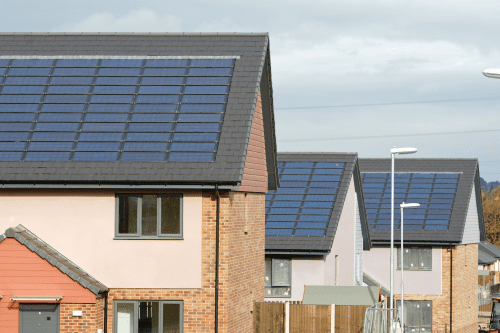Increasingly, Kensa is being approached by social housing clients who have been encouraged to consider the use of solar PV panels to help reduce winter heating costs. Seemingly, some suppliers are suggesting that solar panels will provide a significant additional contribution towards lower heating bills whenever electric based heating systems are used. They won’t. Indeed, in instances where the panels are installed alongside direct electric heating, and that is somehow happening, the heating costs will rise substantially compared to most displaced systems. In this article, Dr Matt Trewhella of Kensa Contracting provides the facts.
The specification of any heat pump, and in particular ground source models, will undoubtedly reduce heating bills whenever oil, LPG or solid fuel boilers are being displaced. Clearly, the technology is also significantly more efficient than any direct electric heating and well designed GSHP systems will even provide modest running cost savings when displacing mains gas condensing boilers. As such, they are a very appealing option for tenants struggling to pay their current energy bills as they deliver the very lowest cost heating.
That all said, the additional investment in solar PV panels will only have a very marginal impact on the heating bill. That is not to say that solar PV panels should not be installed on social properties: they should as they will provide some ‘free’ power, particularly during the summer months, and the system owner will receive a decent financial return via the Feed-in Tariff, cash that could be used to support further energy improvements at the property. But they won’t have much of an impact on tenants’ heating bills and should never be used in combination with direct electric heating if the intent is to provide low cost heat.
In more detail, a typical social house roof can accommodate six PV panels with a system rating of around 1.5kW. An average system will generate around 1250kWh of electrical energy per year. So far, so good given this is low carbon, renewable and free. However, to reduce the householder’s electricity bill, this energy must be used at the same time that it is generated otherwise the excess energy is merely sold back to the grid for a modest payment which benefits the system owner (normally the landlord) rather than the tenant. The tenant must either use or lose the value of the energy generated by the solar PV panels.
Now it is fairly obvious that the panels will generate most of their energy during the day and they will also generate far more in the brighter summer months. And that is hardly helpful when you have only 1250kWh to start with – very few kilowatt hours will be generated when heat is actually required. As a ‘rule of thumb’ around 400kWh might be generated between October and March, the typical heating season. So how does this compare with the energy needs during the same period?
| Electricity Need (October - March) | Energy Demand | Energy Cost |
|---|---|---|
| General electrical demand (lights, TV, computers etc) | 1500kWh | £210 |
| Heating (assuming a direct electric flow boiler) | 10000kWh | £1400 |
| Hot water | 1700kWh | £238 |
| Total | 13200kWh | £1848 |
The table illustrate the solar panels will only produces 400kWh of energy, less than 4% of the total need and, even then, some energy will be exported back to the grid because consumption will not perfectly match generation, especially if the property is not routinely occupied during the day. As a result, the benefit to the tenant through the winter will be minimal; there simply isn’t much free energy to harvest. And that should stop anybody from believing that a PV panel that generates electricity is a perfect partner for a heating system that consumes electricity as they are productive and consumptive at different times of the year.
Finally, a typical solar PV panel roof array will save the tenant around £100 per annum by providing free energy mainly during summer days. And that is good. But it is dwarfed by the potential bill savings that are available when displacing night storage heaters with a ground source heat pump. Obviously, the Feed-in Tariff policy has prompted many landlords to install solar PV panels because there is a compelling financial reward (for the owner) but the emergence of the Renewable Heat Incentive (this scheme has closed) means that even more generous returns are available for investments in heat pump systems. And the beauty is that the tenant benefits far more as well.


